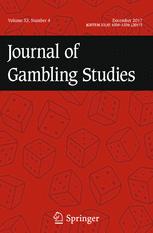 Título: DSM-IV-J Criteria: A Scoring Error That May Be Modifying the Estimates of Pathological Gambling Among Youths
Título: DSM-IV-J Criteria: A Scoring Error That May Be Modifying the Estimates of Pathological Gambling Among Youths
Autores: Christian Jacques, Robert Ladouceur
Data: 2003
Abstract
Previous studies have shown that prevalence rates among youths may be inflated due to a problem in understanding the questions of the SOGS-RA and DSM-IV-MR-J. This article reports another reason why prevalence rates of pathological gambling among youths may be inflated. In 1992, Fisher proposed 9 criteria (the DSM-IV-J) for diagnosing pathological gambling among youths, and formulated 12 questions (the Test questions) to identify the presence of these criteria. An analysis of a sample of studies using the DSM-IV-J reveals that some researchers have incorrectly used the 12 Test questions instead of the 9 criteria, which may have led to overestimated prevalence rates among youths. Other measurement issues may also be contributing to the overestimation of problem gambling in young people. The methodological implications of these issues are discussed.
References
-
American Psychiatric Association. (1994). Diagnostic and statistical manual of mental disorders (4th ed.). Washington, DC: American Psychiatric Association.Google Scholar
-
Becoña, E. (1997). Pathological gambling in Spanish children and adolescents: An emerging problem. Psychological Reports, 81, 275-287.Google Scholar
-
Becoña, E., & Gestal, C. (1996). El juego patológico en niños del 2o ciclo de E.G.B. [The pathological gambling in children of the 2nd cycle of E.G.B.]. Psicothema, 8, 13-23.Google Scholar
-
Derevensky, J. L., & Gupta, R. (2000). Prevalence estimates of adolescent gambling: A comparison of the SOGS-RA, DSM-IV-J, and the GA 20 questions. Journal of Gambling Studies, 16, 227-251.Google Scholar
-
Fisher, S. (1992). Measuring pathological gambling in children: The case of fruit machines in the U.K. Journal of Gambling Studies, 8, 263-285.Google Scholar
-
Fisher, S. (2000). Developing the DSM-IV-DSM-IV criteria to identify adolescent problem gambling in non-clinical populations. Journal of Gambling Studies, 16, 253-273Google Scholar
-
Gupta, R., & Derevensky, J. L. (1998a). Adolescent gambling behavior: A prevalence study and examination of the correlates associated with problem gambling. Journal of Gambling Studies, 14, 319-345.Google Scholar
-
Gupta, R., & Derevensky, J. L. (1998b). An empirical examination of Jacobs’ general theory of addictions: Do adolescent gamblers fit the theory? Journal of Gambling Studies, 14, 17-46.Google Scholar
-
Gupta, R., & Derevensky, J. L. (2000). Adolescents with gambling problems: from research to treatment. Journal of Gambling Studies, 16, 315-342.Google Scholar
-
Krosnick, J. A. (1999). Survey research. Annual Review Psychology, 50, 537-567.Google Scholar
-
Ladouceur, R., Bouchard, C., Rhéaume, N., Jacques, C., Ferland, F., Leblond, J., & Walker, M. (2000). Is the SOGS an accurate measure of pathological gambling among children, adolescents and adults? Journal of Gambling Studies, 16, 1-24.Google Scholar
-
Lesieur, H. R., & Rosenthal, R. J. (1991). Pathological gambling: A review of the literature (prepared for the American Psychiatric Association task force on DSM-IV committee on disorders of impulse control not elsewhere classified). Journal of Gambling Studies, 7, 5-39.Google Scholar
-
Pelletier, A., Ladouceur, R., Fortin, J.-M., & Ferland, F. (2001). Understanding the items of DSM-IVMR-J: An empirical evaluation. Manuscript in preparation, Université Laval, Canada.Google Scholar
-
Shaffer, H.J., & Hall, M.N. (1996). Estimating the prevalence of adolescent gambling disorders: A quantitative synthesis and guide toward standard gambling nomenclature. Journal of Gambling Studies, 12, 193-214.Google Scholar
-
Villa, A., Becoña, E., & Vázquez, F. L. (1997). Juego patológico con máquinas tragaperras en una muestra de escolares de Gijón [Pathological gambling with slot machines in a sample of scholars of Gijón]. Adicciones, 9, 195-208.Google Scholar
-
Wood, R. T. A., & Griffiths, M. D. (1998). The acquisition, development and maintenance of lottery and scratchcard gambling in adolescence. Journal of Adolescence, 21, 265-273.Google Scholar















